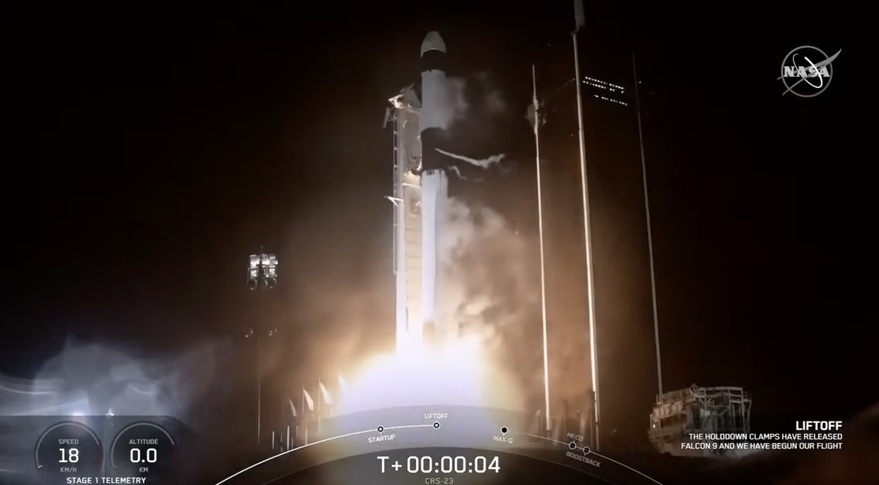WASHINGTON — SpaceX performed its first Falcon 9 launch in two months Aug. 29, sending a cargo Dragon spacecraft to the International Space Station.
The Falcon 9 lifted off from Launch Complex 39A at the Kennedy Space Center at 3:14 a.m. Eastern after a one-day delay because of weather. The Dragon spacecraft separated from the rocket’s upper stage about 12 minutes after liftoff and is scheduled to dock with the station at about 11 a.m. Eastern Aug. 30 for an approximately one-month stay.
The launch was the first for a Falcon 9 since the June 30 launch of the Transporter-2 rideshare mission, the longest pause since a three-month gap between launches from August to November 2019. One reason for the hiatus was a delay in Starlink launches to equip those satellites with laser inter-satellite links; the majority of the Falcon 9 launches this year have been Starlink missions.
“We launch when our customers need us to launch,” Sarah Walker, director of Dragon mission management at SpaceX, said during a prelaunch briefing Aug. 27. She said the company took advantage of the gap to look for “small improvements” in launch operations. “But nothing major changed in terms of preparations for this launch.”
One more significant change is the use of a new SpaceX droneship, called “A Shortfall of Gravitas,” to serve as the landing pad for the Falcon 9 first stage. This droneship, the third in SpaceX’s fleet, features what Walker called “great upgrades,” including the capability to operate completely autonomously. On this launch, though, the droneship was accompanied by a tug, as with previous droneship missions.
It joins “Just Read the Instructions” for supporting launches from Cape Canaveral. “We needed a third vehicle to support the high launch cadence we’re seeing at SpaceX right now,” she said. The third droneship, “Of Course I Still Love You,” is now in California for upcoming launches from Vandenberg Space Force Base.
The Dragon is carrying 2,207 kilograms of cargo, about half of which is research, from materials science to biology. Also on the spacecraft is a small robotic arm developed by Japanese company GITAI that will be tested in Nanoracks’s Bishop commercial airlock, as well as various hardware components for the station.
Unlike many previous Dragon cargo missions, there is no external cargo in the trunk section. Jennifer Scott Williams, manager of the applications client support office for the ISS program at NASA, said that “supply issues and other interruptions due to the pandemic” caused payloads intended to go in the trunk on this launch to slip to future missions. That includes a payload for the Defense Department’s Space Test Program, called STP-H7, which will now launch together with STP-H8 on the next cargo Dragon mission later this year.
This cargo Dragon previously flew the CRS-21 cargo mission in late 2020, and is the first of the upgraded cargo Dragons, introduced on the CRS-21 mission and based on the Crew Dragon spacecraft, to be reused. Walker said upgrades to the cargo Dragon allowed SpaceX to cut the time needed to refurbish the spacecraft to half or even a third of that needed for the first-generation cargo Dragons.
The Falcon 9 booster on this launch was on its fourth flight, having previously launched the Crew-1 and Crew-2 commercial crew missions and, most recently, the SXM-8 communications satellite.
